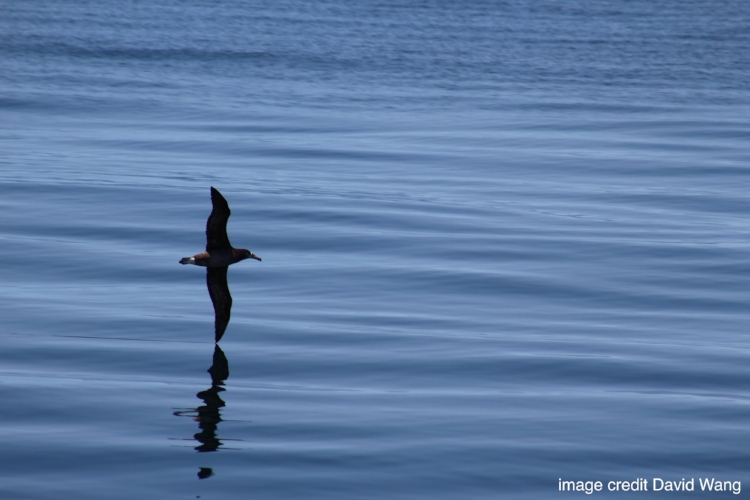Farallon Institute Newsletter - Summer 2018
A black-footed albatross trails a wing-tip along the ocean surface. Image captured during seabird surveys on the NOAA Juvenile Rockfish Cruise, May/June 2018.
Around The Office
Farallon Institute has hired two Post-Doctoral Researchers: Dr. Simon Dedman, who is working on California Current anchovy population dynamics, and Dr. Brian Hoover, who is working on the distribution of krill and its importance to predator populations. Read more about their work here and on their staff profiles.
Farallon Institute physical oceanographer and atmospheric scientist, Dr. Marisol Garcia-Reyes, has been invited to serve as a member of the Eastern Boundary Upwelling System (EBUS) Research research group of the World Climate Research Programme's Climate and Ocean: Variability, Predictability and Change Project (CLIVAR). Their objective is to better understand and predict ocean-atmospheric coupling and the impact on Earth's climate system.
State of the Ocean - Summer 2018
Despite the warm summer and fall of 2017, we are observing productive conditions this year, with strong and early upwelling of cool, nutrient rich water. These data can be seen via our ocean-climate indicator MOCI or at the Bodega Marine Lab Ocean Observation site. Concurrently, improved biological productivity is also being observed: During the 2018 National Marine Fisheries Service Juvenile Rockfish Ecosystem Survey cruise (May-June), a high abundance of anchovy and krill (see picture below!) were observed throughout central California, and on Alcatraz Island in San Francisco Bay there are record numbers (~1,900) of breeding pairs of Brandt's cormorants.
Whale tales and seabird sentinels: increased abundance in a productive year
Farallon Institute scientists participated in the 2018 Juvenile Rockfish Ecosystem Survey (JRES) cruise, an annual mid-water trawl survey that assesses young-of-the-year fish stocks throughout California waters over a 5-week period. These cruises also provide an opportunity to collect data on marine predators such as sea birds and marine mammals, which are conspicuous indicators of ecosystem health and stability. During the 2018 JRES cruise, seabird surveys were conducted on board the NOAA vessel R/V Reuben Lasker, and documented the highest encounter rate of humpback and fin whales observed yet over a 23-year period. Humpback and fin whale sightings were especially common in outer Monterey Bay, Halfmoon Bay, and the Gulf of the Farallones, reflecting the cool water, strong upwelling, and increased biological productivity this year. In comparison, seabirds sightings also increased in 2018, yet none of these increases were significantly greater than the normal range of interannual variation. Even in a productive year, we continue to see the hallmarks of a complex ecosystem: unpredictable species responses to a dynamic environment!
Saildrone returns to San Francisco
Saildrone monitors the ocean outside of San Francisco Bay
The Saildrone unmanned surface vehicle was deployed to collect data on a 60-day cruise from San Francisco Bay, down along the US/Mexico coast to Guadalupe Island and back, from April 2018 to June 2018. This cruise track was chosen in order to sample regions with highly dynamic coastal upwelling, with exceptionally low cloud cover to facilitate satellite clear-sky validation, and to optimize the collocation of Saildrone data observations with existing data from the NOAA National Data Buoy Center moored buoys and coastal High Frequency (HF) radar surface currents. Scientific objectives include studies of upwelling dynamics, air-sea interactions including frontal regions and diurnal warming regions, and ocean ecology. The validation objectives were to establish the utility of Saildrone measurements for inclusion into ocean models and validation of glider observations and satellite data including sea surface temperatures, ocean currents, and wind vectors.
Farallon Institute scientists attend international climate conference
In June 2018, Bill Sydeman, Emily Klein, and Sarah Ann Thompson attended the 4th International Symposium on the Effects of Climate Change on the World’s Oceans in Washington, D.C. Bill co-convened an all-day workshop titled “What do seabirds reveal about the effects of climate change on the world’s oceans?”, which was attended by approximately 20 participants and featured invited speakers from the U.K.
Contributions by FI to the conference also included:
Bill and Sarah Ann were co-authors of a presentation titled “Marine ecosystems and extreme events: A global analysis through the lens of seabirds”, presented by Bill, in a conference session about “Ocean extremes and their impact on marine ecosystems”,
Bill and Marisol Garcia-Reyes were co-authors of John Piatt’s presentation on “Extreme response of seabirds to extreme climate events in the NE Pacific, also in the “Ocean extremes...” session,
Bill was a co-author on the presentation “Functional responses of marine birds to local and global changes in climate and prey availability” by Claire Saraux, which was an invited presentation for the seabirds workshop,
Bill and Sarah Ann were also co-authors on the presentation “Famine in a time of plenty—a recent paradox in the Benguela upwelling system”, presented by South African collaborator Rob Crawford, in the session “Management and conservation of species on the move”, and
Emily presented a poster titled “Ecosystem outcomes of climate change and fishing impacts on krill, Euphausia superba, in the Scotia Sea, and their implications for management in a changing ocean” for the session “Climate change impacts on high latitude systems on multiple scales in space and time”.



